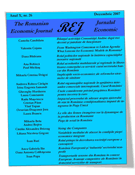Abstract:
Ten years ago Serbia started transition from centrally-planned to market economy. As a latecomer, Serbia faced many challenges in that process. One of those is current account deficit. Subject of this paper is one of balance-of-payment’s most important account – the current account and its deficit in CEFTA-member countries, with the special attention to Serbia. After the introduction, first we examine general issues of balance of payment theory and policy: whether conventional wisdom regarding its equilibrium, as one of finite macroeconomic goals, is valid in a modern international monetary system or not.Traditional balance-of-payment theory had been focused on current account.Modern globalized world economy pushed focus from balance-of-payment’s theory and policy to capital account issues, as presently more important account, while current account is only result of capital one’s misalignments, and something that compensate it and cover balance of payment discrepancy.That is the reason why traditional question “how to avoid high and rising current account deficit” turned into the question “how to manage high and increasing foreign capital inflow”.These questions are even more important for small and open economies in transition, which is exactly the Serbian economy. Secondly, we analyze threats for economic policy decision makers in Serbia, with special regard on current account deficit, whose importance rise in time of world financial and economic crisis, which redirect funds that use to inflow from developed countries to the others. Finaly, we examine both current account deficit sustainability and its financing. Conclusion is reserved for research's results.
